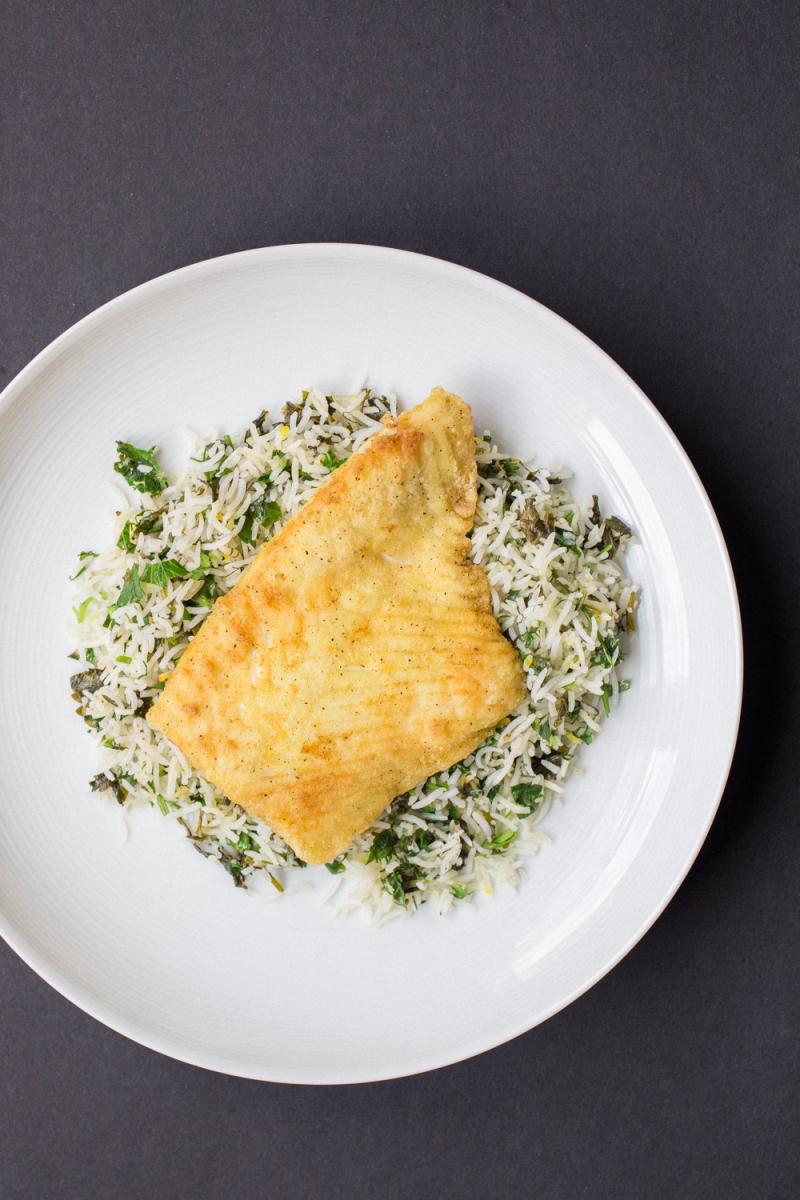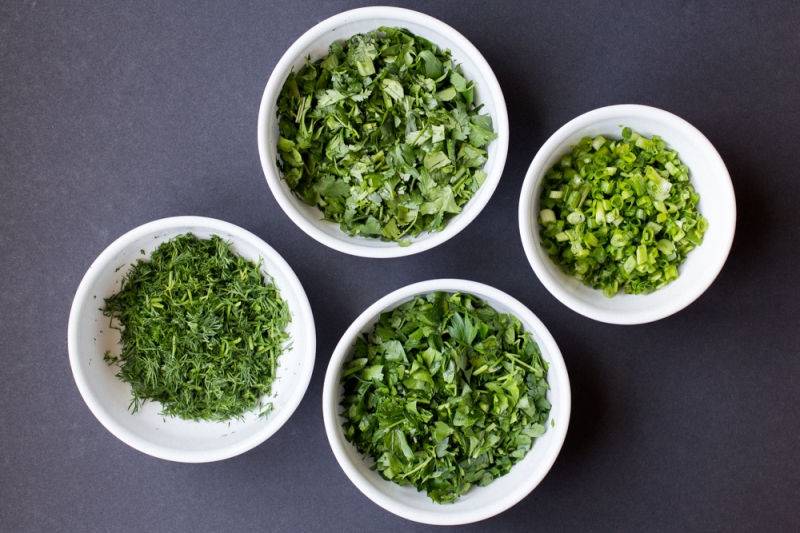
Sabzi Polo is a traditional Persian herbed rice pilaf. There are several different ways to cook rice in Persian cuisine, but Polo (parboiled and steamed) is the most popular. This dish in particular is eaten during the Persian New Year (Nowruz, late March) and served with white fish. The type of white fish varies from rare local fish like Caspian kutum to something more accessible, like halibut or tilapia.
Rice is a critical food source in modern day Iran, and has a long history in the region; it was first introduced from South Asia around 1000 BC, and has been grown in northern Iran ever since. It’s also commonly believed that rice entered Europe via Ancient Persia.
It’s exciting to see that white rice is gaining more acceptance in the Paleo community. I started adding white rice to my version of the Paleo diet in early 2011 (here is an old post about it) and it’s definitely had a positive impact on my overall wellness. I explain many of my reasons for eating rice in my book, but the long story short is that it’s an ancient, delicious, satisfying, and neutral starch (it has fewer toxins than many foods we consider Paleo, like coconut and almonds – reference) whose glycemic load is easily tempered by eating low-glycemic varieties (basmati rice in particular is lower (28) than regular white rice (43) – reference). When eaten as part of a whole meal with added fats and acids, its glycemic index is even further diminished (reference). There are still people that have digestive issues with rice, but for everyone else, it may warrant a place on your dinner table.
Sabzi Polo is an excellent example of an optimal way of eating rice, since it’s paired with a huge amount of herbs – much more than your typical dish – and considering Mathieu Lalonde’s AHS 2012 talk where he found that herbs and spices are second only to organ meats in terms of nutrient density, it’s always good to eat lots of herbs.
This recipe is part of a collaboration with my friend Naz of Cinnamon Eats – after having several discussions about Persian rice dishes, we decided to each write up a recipe to highlight the varied and delicious choices available in Persian cuisine. Be sure to check out her half of the collaboration: Zereshk Polo (Persian Barberry Rice).

The five herbs listed (parsley, cilantro, dill, fenugreek, and green onions) are only a suggestion; if you can’t find all five, don’t let that prevent you from making this dish! Personally, I don’t have fresh fenugreek available in my area, so I went without it.
Sabzi Polo ba Mahi (Persian Herbed Rice with Fish)
2 cups basmati rice
1/2 tsp salt
1 bunch flat leaf parsley, chopped
1 bunch cilantro, chopped (~1 cup)
1 bunch dill, chopped (~1 cup)
1 bunch fenugreek, chopped (~1 cup)
1 leek or 10 green onions, chopped (~1/2 cup)
2 tbsp coconut oil
1 potato, cut into 1/4″ slices (optional, see below)
2 tbsp butter (ghee okay), melted
5 strands saffron, crushed
2 tbsp ghee (coconut oil okay)
1/4 cup tapioca starch
1/2 tsp salt
1/2 tsp black pepper
1/4 tsp turmeric
4 filets white fish (tilapia, halibut, flounder, etc)
To make the rice:
1. Soak the rice in lukewarm water for at least 1 hour but up to 6 hours; the longer you soak the rice, the fluffier it will be. After soaking, drain, rinse, and add the rice to a stockpot. Fill the stockpot with water and 1/2 tsp salt, bring to a boil over high heat, then reduce heat to medium once it starts boiling; simmer until the rice softens and starts to freely float to the top of the water, about 8 minutes. Drain the rice and set aside.
2. In the stockpot (which should still be warm), add the 2 tbsp coconut oil and line the bottom of the pot with potato slices. These potato slices will prevent the rice from drying and will also be delicious and crispy when the rice is done cooking. Alternatively, you can omit the potato, which will give the bottom rice a nice, golden crunchy layer (called Tahdig). Your call! We like the crispy potatoes, but often make Tahdig instead.
3. Scoop 1/3 of the rice into the pot, being careful not to shake the pot so that the rice doesn’t compact. Cover the rice with 1/3 of the chopped herbs. Spoon in another 1/3 of the rice, then another 1/3 of the herbs. Finally, add the remaining rice. Mix the melted butter (or ghee) with the crushed saffron, then pour over the rice in a circular pattern. Wrap the stockpot’s lid in a kitchen towel (demonstrated here) then cover; cook on medium-high heat for 5 minutes, then reduce heat to low and simmer for 40 minutes. Uncover and carefully stir together with a spatula, then stir in the final 1/3 of the fresh herbs.
To make the fish:
1. In a skillet, warm the ghee or coconut oil over medium/high heat for 1 minute. Combine the tapioca starch, salt, pepper, and turmeric in a shallow pan. Dredge the fish filets in the tapioca starch mixture, one at a time, shaking off any excess starch. Add the filets to the skillet (cook in batches if needed, don’t overcrowd the skillet). Cook for 3 minutes, carefully flip the fish, then continue to cook until the fish is done, about 3 more minutes depending on the thickness of the fillets. The fish is done when it just starts to flake (it will finish cooking when removed from the heat). If cooking the fish in batches, add more ghee/oil with each batch. Serve over the herbed rice.

I used halibut for this recipe but any white fish will do.

Mixing the cooked and fresh herbs adds a tasty dynamic to the dish.

Russ this looks fantastic! I love your approach to this dish and so glad you included the tahdig part as well :) I had a lot of fun collaborating with you on this!
LikeLike
Yum! This looks amazing!
LikeLike
Love it!
LikeLike
I’m not a big rice fan but this one , yum!
LikeLike
This is stunning. I’ve been meaning to make Polo or pulao for a long time, but I haven’t found a free afternoon to do it. I’ve been following a lot of Iranian and Indian cooks and it just seems to take forever. Yours looks gorgeous. The tahdig is the best part.
LikeLike
Thank you for giving me permission to eat a little rice again. ;>) Some of my in-laws are from Peru and they often have potatoes and rice in a meal. Odd that half a world away a Persian dish would feel right at home in Peru.
LikeLike
Looks delectable. I wish I could find fenugreek greens nearby…they’re kind of hard to track down!
LikeLike
Fenugreek can always be found in Indian grocers under the name methi bhaaji and in Persian shop ask for shambaleli
LikeLike
I’ll definitely try this weekend.
Do try fruity fish..
http://bit.ly/1jhzlea
LikeLike
I made this today and it was delicious. I couldn’t find all the herbs listed so I used cilantro, parsley, chives, oregano, fennel and dill. I also squeezed some lemon into the rice and on the fish at the end. Very nice. Thank you.
LikeLike
Hi Russ did you know that NBA stars Kobe Bryant and Ray Allen eat Paleo as does Kellen Lutz? Pax Robbie in San Diego
LikeLike
Love this- coming from a Persian background, I wondered how long before these recipes would start showing up! There’s so much goodness that goes into these dishes- I look forward to seeing more
LikeLike
This is a great post. Thanks for the explanation on rice. As an Ayurvedic blogger, mostly grain free, we do cook occasionally with Basmati. I knew it to be the lowest glycemic of all rices, but didn’t know a Paleo might find it acceptable. Your reasoning makes sense and your herb addition is utterly Ayurvedic – so it looks like one more validation for this ancient way! Will share.
LikeLike
I love Persian food as my husband is iranian. I am going to try to make this dish for the first time this persian new Year. I’m quite confused though about how to make the Mahi…
LikeLike
Love Iranian food. Will make this dish tomorrow. Lived 10years with an Iranian family. Can speak Farsi fluently. I am from Mauritius.
LikeLike